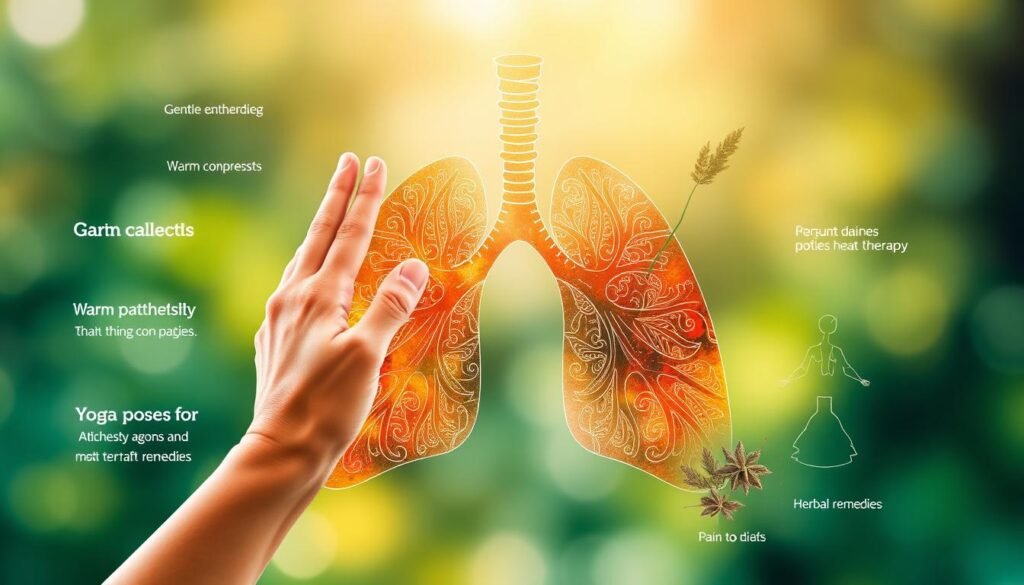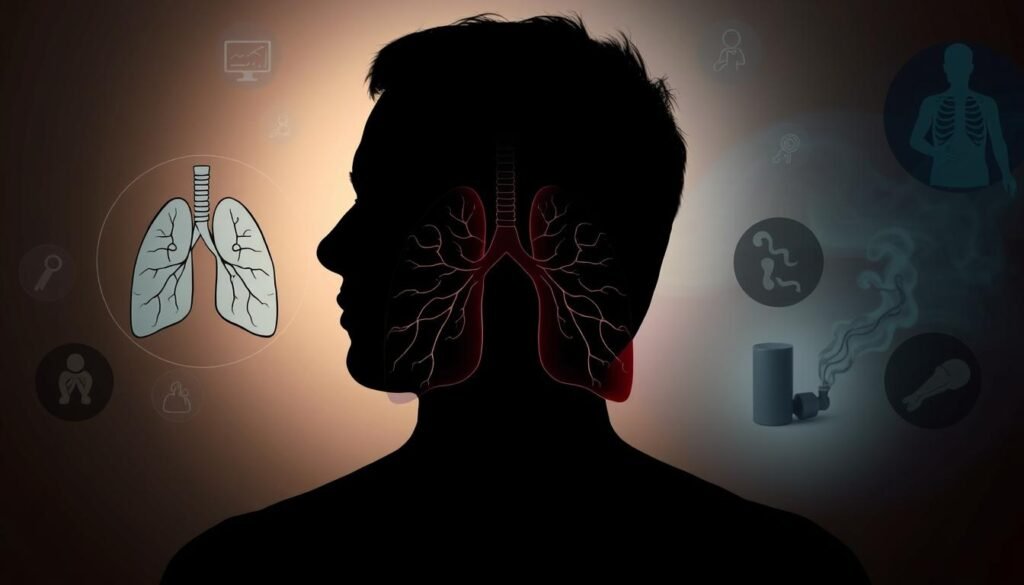Did you know about 25% of people with lung cancer face chronic back pain? This fact shines a light on back pain’s importance. It’s a symptom we must not ignore. Recognizing how back pain and lung cancer are connected is key for managing the pain effectively. For many, back pain stems from complications like spinal metastases, greatly affecting their life. Early understanding of this can help in finding the right cancer treatment options to ease the discomfort.
Palliative care is crucial in dealing with these issues. It looks after the physical and mental health of patients. Healthcare providers can tailor a plan that focuses on relieving pain. This plan helps support patients throughout their treatment. If you’re seeking deeper insights into lung cancer and back pain, check out this informative guide.
Key Takeaways
- Approximately 25% of lung cancer patients experience back pain as a significant symptom.
- Chronic back pain often leads patients to seek emergency care, making understanding its causes crucial.
- Back pain may stem from factors like spinal metastases, infections, or other lung-related issues.
- Palliative care is essential for improving quality of life through effective pain relief strategies.
- Early detection of back pain in lung cancer patients can lead to better treatment outcomes.
- Lifestyle changes and home remedies can support chronic back pain management alongside medical treatment.
Understanding Back Pain in Lung Cancer Patients
Lung cancer patients often find back pain challenging. It’s a significant symptom that’s less obvious. About 25% of people with lung cancer feel back pain. This may happen before they even know they have cancer. The cause of this discomfort varies, so it’s crucial for patients to watch their health closely.
Common Symptoms of Lung Cancer
Back pain is a common symptom among various signs of lung cancer. Other symptoms include:
- Persistent cough lasting over two weeks
- Shortness of breath and fatigue
- Chest pain and hoarseness
- Coughing up blood
- Recurring chest infections
- Weight loss and loss of appetite
- Swelling in the neck or face
- Chronic pneumonia or bronchitis
As cancer grows, the back pain may get worse. This calls for more medical checks.
How Back Pain Relates to Lung Cancer
Back pain can happen if lung tumors press on nearby areas. It can also occur when cancer spreads to the spine. This is known as bone metastasis. It’s a major source of back pain for many. Patients and support groups like MyLungCancerTeam talk about it often. Doctors may use X-rays, CT scans, and MRIs to find the reason for the pain. They look for issues like pressure on the spinal cord or leptomeningeal metastasis.
Knowing how back pain and lung cancer are linked helps spot problems early. It shows why talking to doctors about back pain is key. This can lead to faster help and better ways to manage back pain.
Identifying Back Pain Symptoms in Lung Cancer
Knowing signs of back pain in lung cancer is key for quick help. Patients often talk about a certain kind of back pain linked to cancer. This pain is different from normal back pain. Spotting the differences helps patients and doctors manage the pain better.
Characteristics of Cancer-Related Back Pain
Cancer-related back pain is hard to figure out. Some say it feels like muscle soreness. Others say it’s sharp, like nerve pain. It might happen at night, spread to the legs, or feel deep in the bones.
Sometimes, muscle weakness or bathroom changes hint at spine issues. Early on, bone pain might be the first clue of cancer, affecting some lung cancer patients.
Differences Between General Back Pain and Cancer-Related Pain
It’s important to tell general back pain from cancer pain apart. Normal back pain can come from muscle strains or lifestyle and might get better with usual treatments. But, cancer pain stays and often gets worse. If there’s tingling, weakness, or ongoing pain that treatment can’t help, it could mean something serious. Knowing these signs helps catch cancer early, leading to better treatment chances.
| Characteristic | Cancer-Related Back Pain | General Back Pain |
|---|---|---|
| Duration | Persistent, worsening over time | Often transient, may improve with care |
| Pain Type | Dull ache or sharp pain | Varies, usually muscle-related |
| Associated Symptoms | Neurological signs, bowel/bladder changes | Occasional stiffness or limited mobility |
| Location | Commonly in the spine and legs | Can be localized or diffuse |
| Response to Treatment | May not improve, requires specific cancer treatments | Often improves with rest or over-the-counter medications |
If you have back pain that doesn’t go away, see a doctor. Spotting symptoms early can really help with treatment success. It makes monitoring characteristics of cancer-related back pain very important.
Causes of Back Pain in Lung Cancer Patients
Knowing why lung cancer patients get back pain is key. It can come from cancer spreading to the spine, side effects of treatments, or body structure issues. Learning about these causes helps find the right treatment.
Spinal Metastases and Their Impact
About 19% of patients with lung cancer spread face spinal metastases. This makes the cancer press on spinal nerves, causing pain. Such pain may feel dull or sharp and gets worse at night, possibly leading to leg weakness or mobility issues.
It’s important to connect these symptoms to cancer spread for quick action.
Leptomeningeal Metastasis Explained
Leptomeningeal metastasis happens when cancer hits the brain and spinal cord’s protective layers. Though it affects a small percentage of patients, the impact is huge. Symptoms like back pain, headaches, and limb weakness call for urgent checks.
Radiation Effects and Other Treatment-Related Causes
Radiation therapy for lung cancer can inflame or alter the spine. This often leads to back pain. Pain might also arise from chemotherapy, especially in patients new to back issues. Recognizing these sources is crucial for managing pain effectively.
To understand more, patient can look up resources on signs of lung cancer-related back pain here.
Treatment for Back Pain Caused by Lung Cancer
Treating back pain from lung cancer needs various strategies. Different treatments improve life quality depending on the pain level. These may include medications and non-drug treatments.
Medications for Pain Relief Strategies
Doctors may prescribe different medicines for back pain. For mild pain, non-opioid analgesics are helpful. With severe pain, stronger medicines, like opioids, are used. Corticosteroids can reduce inflammation, easing pain.
Non-Pharmaceutical Treatments
Besides medicines, non-drug treatments play a big role. Physical therapy strengthens the back and increases mobility. Techniques like acupuncture and massage also relieve pain. These methods support overall cancer care, helping manage lung cancer-related pain.

Knowing the different cancer treatment options helps in making decisions. It’s important for patients and caregivers to discuss pain management and well-being.
| Treatment Type | Effectiveness | Examples |
|---|---|---|
| Medications | Varies (mild to severe pain) | Non-opioid analgesics, opioids, corticosteroids |
| Physical Therapy | Effective | Strengthening, mobility exercises |
| Acupuncture and Massage | Promising | Holistic symptom relief |
Palliative Care for Back Pain Management
Palliative care is key in improving life quality for lung cancer patients. It focuses on easing back pain and supporting well-being. Specialists tailor strategies to manage symptoms comfortably.
Role of Palliative Care in Cancer Treatment
Palliative care helps manage back pain in lung cancer cases. Pain may come from tumors, treatment effects, or the cancer itself. Experts use medicines, physical therapy, and other therapies for relief.
This care complements other treatments like chemotherapy. It ensures a well-rounded care plan that improves pain and life quality.
Integrative Approaches in Palliative Care
Integrative care in palliative treatment involves teamwork to support patients. It offers mental health support, nutrition tips, and lifestyle changes. This combination improves pain management, emotional health, and openness to treatment.
By focusing on different health aspects, palliative care seeks a balanced care plan. It aims to lessen back pain and boost the overall experience for lung cancer patients.
| Approach | Description | Benefits |
|---|---|---|
| Pain Management | Use of medications, physical therapy, and interventions to relieve pain. | Improves comfort and quality of life. |
| Mental Health Support | Counseling and therapy to address emotional well-being. | Enhances coping mechanisms and reduces anxiety. |
| Nutritional Guidance | Personalized diet plans to support health during treatment. | Boosts energy and overall health. |
| Lifestyle Modifications | Incorporating exercise, relaxation techniques, and self-care routines. | Promotes physical and mental resilience. |
Creating a Comprehensive Pain Management Plan
Creating a detailed plan for managing pain is crucial for lung cancer patients. It combines expert care with personal steps to ease pain. Teams of oncologists, pain experts, and palliative care staff work together to tackle cancer pain.
Collaboration with Healthcare Providers
Working together is key for cancer patients fighting back pain. A team from various medical fields provides all-around care. Keeping in touch regularly helps tailor treatments. This teamwork improves how patients cope with back pain.
Incorporating Lifestyle Changes and Home Remedies
Making small changes in your lifestyle can help control back pain. Consider these tips:
- Ergonomic adjustments make everyday tasks more comfortable.
- Posture improvements lessen back stress.
- Stretching exercises boost flexibility and strength.
- Maintaining a healthy weight reduces spine pressure.
These adjustments can significantly lower pain. It allows patients to actively improve their condition.

Advanced Treatment Options for Severe Back Pain
Patients dealing with severe back pain from lung cancer need special treatments. These treatments are key to making life better. They include surgeries and radiation therapy for problems in the spine caused by cancer.
Surgery for Spinal Issues Caused by Cancer
In some situations, surgery is critical when tumors affect the spine’s stability or squeeze nerves. The main goals of surgery are to ease pressure on the spinal cord or nerves. This can lessen pain and improve how well the body works.
Different surgeries might be needed, depending on the situation. These can be removing tumors, making the spine stable, or surgeries to free up space. Such procedures can greatly improve how someone moves and reduce long-term pain.
Radiation Therapy for Tumor Reduction
Radiation therapy is a key option for shrinking tumors that cause ongoing back pain. Shrinking tumors helps lessen pain and makes moving around easier. Radiation targets cancer cells to help manage pain. It also aims to boost overall comfort and how well someone can function.
Thanks to new techniques, radiation therapy has become very precise. It focuses on the problem areas without harming nearby healthy parts. This targeted approach helps in reducing symptoms more safely.
Importance of Early Detection and Intervention
Knowing how crucial early detection is can vastly improve lung cancer patient outcomes. Timely detection leads to the effective handling of symptoms, such as back pain.
Recognizing Warning Signs of Cancer Progression
It’s vital for both patients and doctors to watch for early signs of cancer getting worse. A sudden change in back pain is a red flag. Symptoms like continuous cough, breathlessness, or unexplained weight loss need quick attention.
Spotting these signs early can lead to prompt action. This is key for successful treatment and better life quality.
The Role of Regular Medical Check-Ups
Consistent medical check-ups are crucial in monitoring lung cancer. These appointments allow doctors to evaluate pain and update treatment plans. This is how care becomes more effective.
For example, more than 85% of patients under palliative care got personalized help, improving their pain and treatment journey. With regular tests like CT scans, doctors can adjust treatments early. This shows why early detection is so important.

Complementary Therapies for Back Pain Relief
Complementary therapies can help manage back pain. Besides traditional treatments, they boost holistic well-being. This includes both physical and emotional health.
Acupuncture and Massage Therapy
Acupuncture is a key practice from traditional Chinese medicine. It uses thin needles to target specific body points. Many patients, especially those with cancer, find back pain relief through acupuncture. Although strong evidence is lacking, its popularity in cancer care centers shows its value.
Massage therapy is another supportive method. It encourages relaxation and lessens pain. By easing muscle tension, it promotes a sense of well-being. This break from daily stress is very beneficial for patients in treatment.
Physical Therapy and Exercise Recommendations
Custom physical therapy plans are essential for back pain sufferers. These plans aim to strengthen the back and improve flexibility. Activities like stretching and strength training are key. They increase strength and pain resistance.
It’s important to talk about exercise plans with doctors. This team effort helps manage pain better, possibly reducing the need for medications. Exercise, combined with professional advice, greatly enhances life quality.
| Complementary Therapy | Benefits | Considerations |
|---|---|---|
| Acupuncture | May reduce pain and promote relaxation | Consult with healthcare provider about interactions |
| Massage Therapy | Reduces muscle tension and stress | Ensure therapist has experience with cancer patients |
| Physical Therapy | Strengthens back and improves mobility | Tailor exercises based on individual needs |
When considering these therapies, combining them with standard treatments is key. For more info, visit complementary and alternative therapies.
Conclusion
Helping lung cancer patients with back pain is very important. Every year, a lot of people are diagnosed with lung cancer. Knowing how to treat back pain from lung cancer is key to improving their lives. In this article, we talked about many ways to manage back pain. These methods include medicine and non-medicine based therapies. They help create a plan that works for each patient.
Working with doctors and nurses is crucial for patients with back pain. When patients talk openly with their healthcare team, they get better care. This means they can use regular and extra therapies together. This way, they not only feel less physical pain but also feel better emotionally.
Dealing with cancer comes with many hurdles. But with the right actions and support, patients and their helpers can lessen back pain. Through taking care of back pain in many ways, those with lung cancer can get some relief. They can then face their treatment with more hope for good results.